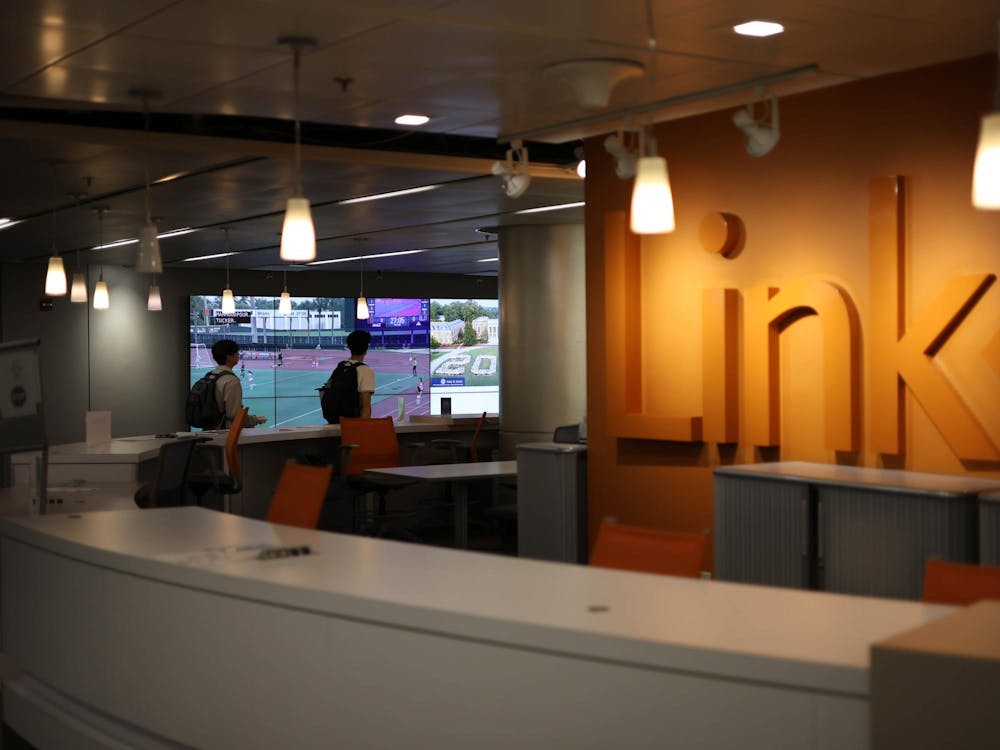A recent collaboration at Duke can allow colorblind students and faculty to approach their studies and work through a new lens — literally.
The initiative between Fitzpatrick Institute for Photonics (FIP), The Link, Duke Access and Accommodation Services (AAS) and EnChroma — a color-enhancing lens brand — allows any colorblind Duke community member to test out color-enhancing glasses. The seven pairs of glasses available are designed for people with red-green color blindness and can be borrowed at The Link for up to a week at a time.
The glasses reportedly increase color contrast for 80% of red-green colorblind individuals.
Those who are red-green colorblind experience overlap in their red and green frequencies, meaning that they are unable to fully distinguish between the two colors. According to August Burns, Pratt School of Engineering departmental business manager of FIP, the EnChroma glasses function to solve that exact problem.
“[The lenses] put a divider [between] those wavelengths, so that you have definite green and a definite red,” she said. However, she emphasized that these glasses do not “guarantee” that those who are colorblind can automatically distinguish between colors. Instead, the glasses work to enhance one’s capabilities based on the extent to which their red and green color-sensing cones overlap.
Due to this mechanism, EnChroma notes that different people will have different experiences with the glasses. Burns noted that those who had trouble seeing red versus blue had different experiences with the glasses. She also shared that among the people she initially tested the glasses with, their experience with the glasses varied, with some noting drastic differences in their color perception and with others experiencing marginal improvements.
Despite people having different experiences with the glasses on the first wear, a study conducted by the University of the Incarnate Word concluded that colorblind subjects experienced sustained improvements in color vision after 12 days of using EnChroma glasses, even when without wearing them.
According to Burns, support for the program came from a wide range of individuals, including Tuan Vo-Dinh, R. Eugene and Susie E. Goodson distinguished professor of biomedical engineering, Ashley Lunn, director of assistive technology and digital media at AAS, and Rodney Cozart, the Office of Information Technology service desk manager.
In particular, Burns noted that she wanted to work with The Link — which already has a system in place for the Duke community to borrow a range of technologies — to make EnChroma glasses accessible. Therefore, she collaborated with Cozart to figure out certain logistics, such as how to catalog the glasses, impose time limits and penalties for failing to return the glasses, and place a label on the glasses, which Burns characterized as an initial “hurdle of the process.”
Ultimately, Burns shared that the goal of the initiative is to observe if the glasses are “helpful” to students, either in the academic space conducting research or in their day-to-day lives.
“The general goal is to see if [the glasses] are helpful,” Burns said. “If the student feels like this is accessible to them, that's huge,” adding that they could continue to check out the glasses for specific classes or labs.
Since the program has been announced, there have been discussions with Duke Access and Accommodations Services to expand the EnChroma program to a greater variety of people and for a wider range of circumstances.
“[The office] want[s] to get some pairs to make it accessible to everyone, like [if] a visitor comes … or if a student needs it for the semester, versus a week.” Burns said.
She also expressed interest in ideas to have the glasses be available at the first floor reception desks of the library and at the Medical Center to increase outreach.
“That's what it's about, just getting the word out there so that if [community members] want [it], it’s out there,” Burns said.
In addition to The Link, The Nasher Museum also offers four pairs of EnChroma color-enhancing glasses to guests: two for adults, one for children and another that can be worn over regular glasses.
The partnership with Duke works to “build on EnChroma's broader collaborations with institutions such as museums, schools and parks to promote color accessibility,” wrote EnChroma Marketing Manager Cecilia Gerosa in an email to The Chronicle. The company has also collaborated with the Metropolitan State University of Denver, as well as the Peabody Essex Museum and the Color Factory.
According to an article published by The Pratt School of Engineering, one in 12 men and one in 200 women are colorblind. Based on these statistics, it is estimated that more than 1,400 students and 900 faculty at the University may be colorblind.
“The whole point of [FIP] is to bring people together, solving problems using light,” Burns said. “… [and] this was a problem that I thought of as a staff person … [that] in our outreach, color blindness is something we [hadn’t] really touched on.”
Get The Chronicle straight to your inbox
Signup for our weekly newsletter. Cancel at any time.
Winston Qian is a Pratt sophomore and health/science editor for the news department.

